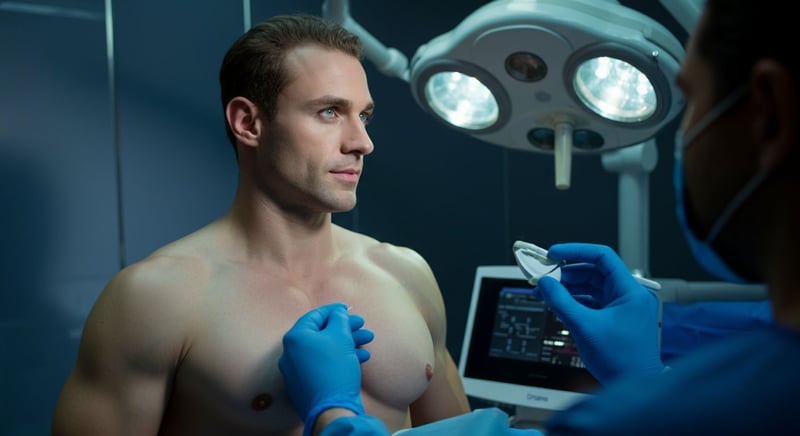Gynecomastia: Decoding Man Boobs & Male Breast Reduction
Delve into the causes and treatments of gynecomastia, from hormonal imbalances to effective reduction strategies, surgical and beyond.
Gynecomastia, often jokingly referred to as 'man boobs,' is a medical condition characterized by the enlargement of male breast tissue. It can be a source of embarrassment and emotional distress. Thankfully, there are both surgical and non-surgical treatment options available. Understanding the causes, differentiating true gynecomastia from pseudogynecomastia, and exploring various treatment pathways are crucial for those seeking solutions.
What is Gynecomastia and What Causes Enlarged Male Breasts?
Understanding the Core of Gynecomastia
Gynecomastia is an enlargement of the male breast tissue typically caused by an imbalance of the hormones estrogen and testosterone. Various factors can lead to this imbalance, including natural hormonal changes, certain medications, and underlying health conditions. Recognizing these causative elements is vital for effective treatment planning. Often individuals wonder about the specifics surrounding gynecomastia, from its emergence to potential interventions. For example, 65% of adolescent males experience some degree of gynecomastia during puberty.
Common Contributing Factors to Gynecomastia
- Hormonal Imbalance: Fluctuations in estrogen and testosterone levels, especially during puberty or aging.
- Medications: Certain drugs like anti-androgens, some antibiotics, and antidepressants can induce breast enlargement.
- Health Conditions: Diseases such as hyperthyroidism, kidney failure, and liver cirrhosis may disrupt hormonal balance.
One of the most common questions is, 'what causes gynecomastia?' The causes can range from puberty-related hormonal changes to issues such as obesity, resulting in increased levels of estrogen relative to testosterone. Key contributing factors include certain medications like anti-androgens, antipsychotics, and heart medications. Conditions like hyperthyroidism, kidney failure, and liver disease can also play a role, making medical assessment crucial for affected individuals. Karaciğer hastalığı olan bir erkekte, bozulan hormon metabolizması nedeniyle jinekomasti gelişebilir. It is important to highlight that while the presence of man boobs can significantly affect self-esteem, estethica Global offers solutions tailored to individual medical conditions.

Gynecomastia vs. Pseudogynecomastia: Identifying the Real Issue
Differentiating Gynecomastia and Pseudogynecomastia Accurately
Distinguishing between gynecomastia and pseudogynecomastia is essential for determining the appropriate treatment strategy. Gynecomastia involves the enlargement of glandular breast tissue in men, whereas pseudogynecomastia results from an accumulation of fat tissue in the chest area. This differential diagnosis is pivotal, directly influencing whether medical, hormonal, or surgical interventions are necessary. For instance, while estethica Global generally addresses gynecomastia through surgical options like male breast reduction, cases of pseudogynecomastia may benefit more from non-surgical weight loss approaches.
Diagnostic Methods for Confirming Gynecomastia
- Physical Examination: A doctor assesses breast tissue to feel for glandular enlargement, differentiating it from fatty tissue.
- Hormonal Evaluation: Blood tests check hormone levels to rule out imbalances contributing to glandular development.
- Imaging Studies: Ultrasound or mammography visualize breast tissue composition to confirm the presence of enlarged glands.
Pinpointing what causes gynecomastia requires a thorough diagnostic process. Initially, a physical examination helps differentiate between glandular and fatty tissue. If glandular tissue is confirmed, hormonal evaluations are conducted to identify imbalances. Imaging techniques such as ultrasound or mammography provide detailed views, confirming the diagnosis. For example, an ultrasound can clearly show the density and structure of the breast tissue, helping rule out other conditions. Proper diagnosis ensures patients receive tailored treatment, underscoring the importance of expert medical assessment provided at estethica Global.

Surgical Solutions: Male Breast Reduction Techniques Explored
Navigating Male Breast Reduction: Surgical Options
When addressing gynecomastia, surgical intervention becomes a viable option, especially when non-surgical approaches yield unsatisfactory results. The primary aim of surgery is to reshape the chest, providing a more masculine contour. Liposuction is frequently employed to eliminate excess fat, while more pronounced cases might require the excision of glandular tissue or excess skin. Selecting a skilled surgeon is vital to achieving desired results. For example, individuals who have significant fat deposits might see substantial improvement with liposuction alone, making it a popular choice.
Understanding the Surgical Process for Gynecomastia
- Liposuction: Suctioning out excess fat through small incisions to sculpt the chest area.
- Excision: Surgically removing glandular tissue and excess skin to create a flatter chest.
- Combination Techniques: Using both liposuction and excision for comprehensive reshaping of the chest.
Surgery usually begins with administering general anesthesia, followed by either liposuction, excision, or a combination of both, depending on the patient’s specific needs. Following surgery, patients undergo a recovery phase characterized by swelling and bruising, which gradually subsides, unveiling a firmer, more contoured chest. For instance, some patients might experience minor discomfort that can be managed with pain medication as prescribed by their surgeon. estethica Global provides comprehensive surgical solutions for those seeking effective treatment for gynecomastia. Understanding how to get rid of gynecomastia might involve exploring surgical options, particularly if hormonal treatments are not sufficient. The right approach can significantly enhance chest aesthetics and overall confidence.

Beyond Surgery: Exploring Non-Surgical Gynecomastia Treatment Options
Non-Invasive Techniques for Managing Gynecomastia
For individuals seeking alternatives to surgery, there are a variety of non-surgical treatments available. These include hormonal therapy to address imbalances, leading to breast tissue reduction, and lifestyle changes such as diet and exercise. Methods such as cryolipolysis or coolsculpting offer non-invasive fat reduction options. For example, hormonal imbalances account for around 25% of gynecomastia cases, which can be effectively managed through targeted therapies. This approach is particularly beneficial for adolescents experiencing gynecomastia due to puberty. At estethica Global, we focus on understanding individual patient needs to recommend the best possible treatment plans.
Exploring Holistic Approaches for Gynecomastia Reduction
- Dietary Adjustments: Incorporating foods that help balance hormone levels can aid in reducing breast tissue.
- Targeted Exercise: Specific exercises can decrease chest fat and improve muscle tone, reducing the appearance of enlarged breasts.
- Medical Treatments: Hormonal therapies prescribed by a doctor can restore hormone balance and reduce glandular tissue.
Exploring how to get rid of gynecomastia without surgery involves looking into dietary adjustments, physical exercise tailored to reduce chest fat, and medical treatments intended to restore hormonal balance. While non-surgical methods may not provide instant results, they offer a less invasive path to alleviating symptoms. For instance, incorporating zinc-rich foods like spinach and pumpkin seeds can naturally boost testosterone levels, helping to balance hormone levels. It is also important to highlight that while the presence of man boobs can significantly affect self-esteem, estethica Global offers consultations to explore all available options.
Liposuction and Excision for Comprehensive Chest Reshaping
estethica global employs liposuction techniques to remove excess fat and sculpt the chest area, utilizing small incisions to minimize scarring. For more complex cases, surgical excision of glandular tissue and excess skin is performed to create a flatter, more masculine contour.
estethica global's surgeons are highly skilled in both liposuction and excision techniques, ensuring patients receive personalized treatment plans tailored to their individual needs. The team's expertise extends to hormonal therapies and lifestyle changes to manage gynecomastia effectively. estethica prioritizes patient safety and satisfaction, combining medical expertise with innovative approaches for chest contouring.
Personalized Treatment Plans and Thorough Post-operative Care
estethica global focuses on understanding individual patient needs to recommend the best possible treatment plans, from hormonal therapy to surgical intervention. The clinic provides thorough post-operative care, characterized by managing swelling and bruising after surgery to reveal a firmer, more contoured chest.
estethica global has a proven commitment to social responsibility through the Murat Akdoğan Vakfı. Patient satisfaction is a top priority, with estethica global striving to provide a supportive and transparent healthcare environment, offering services in world-class technology-equipped facilities.
Frequently Asked Questions
What causes gynecomastia, and how is it diagnosed?
What is the difference between gynecomastia and pseudogynecomastia?
What surgical options are available for male breast reduction?
Are there non-surgical treatments for gynecomastia, and how effective are they?
Ready to discover the "Healthy Beauty" you deserve with estethica's expert team and world-class services?
📞 Call Now for Your Free Consultation!